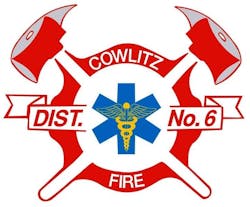WA Firefighters Tout New CPR Machine
By Katie Fairbanks
Source The Daily News, Longview, Wash.
CASTLE ROCK, WA -- For first responders, CPR can be exhausting and difficult to perform effectively for an extended time, especially for a small department like Cowlitz County Fire District 6.
But a new automated CPR machine is helping the Castle Rock department to better respond to cardiac arrests.
“Longview has the manpower to show up with 10 people for a cardiac arrest. For us, it’s tough,” said firefighter and EMT Brandon Poff. The Cowlitz 6 department, made up of seven staff members and 28 volunteers, usually has three to four people respond, he said.
“It’s hard to go on scene knowing there is the technology to help people out there but you don’t have it,” added his wife, Stacie Poff, who is a fellow firefighter and paramedic.
Three months ago, Cowlitz 6 purchased the two new heart monitors and AutoPulse machine to assist in CPR. The equipment cost about $82,000, which the department budgeted for over the years, Stacie Poff said.
The Castle Rock department is the first in the county to get the machine, which includes a constricting band and backboard that performs CPR on patients at a steady rate while hooked up to a monitor that tracks the heart rate. The purchase also includes training and regular upgrades.
The upgrades, which are sent to the department by the machine’s manufacturer, are a big reason they chose the system, Brandon Poff said.
The machine performs steadier chest compressions than people, he said. Even if responders take turns giving CPR, the effectiveness of their compressions decreases over time, he said.
“CPR is exhausting. Survivability can drop as time goes on,” he said. “We’re hoping to raise the survivability of our patients.”
The machine is also helpful if they have to continue CPR as they transport a patient to the hospital because they have a longer way to go than other area departments, Stacie Poff said.
Along with the AutoPulse, the new monitors also improved the department’s response by displaying more information than the old machines and giving emergency responders performing CPR feedback on their effectiveness.
Poff said this is helpful for law enforcement officers, park rangers and department office staff that sometimes have to perform CPR, and allows the paramedics to focus on other things during a response.
The advanced display also cuts down on delays from responders stopping CPR to check the patient’s underlying heart rhythm, she said.
“A few seconds are huge. Any pauses are huge,” Poff said. “When you have long pauses you lose anything you’ve worked for.”
The machine doesn’t completely replace human CPR, she said. Responders will still perform compressions when they first arrive and will hook up the Autopulse when they get a chance, Poff said.
The department will use the machine for all cardiac arrests if they can get it on the patient without pausing CPR for too long, she said. The Autopulse should only take about 10 seconds to get on a patient, but Poff said since they are still getting used to it, they’ve taken about 20 to 30 seconds to get it set up.
Poff said the biggest challenge is fitting the AutoPulse set up into their old response routine, which will take more practice. They have used the machine on about five cardiac arrests so far, she said. The department responds to about 20 to 30 cardiac arrests per year.
“It’s really all about providing the best care we can for our community and increasing survivability rates,” she said.
———
©2019 The Daily News, Longview, Wash.
Visit The Daily News, Longview, Wash. at www.tdn.com
Distributed by Tribune Content Agency, LLC.






